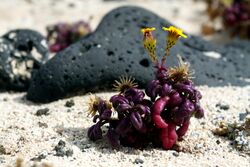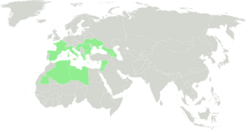Biology:Senecio leucanthemifolius
| Coastal ragwort | |
|---|---|

| |
| Scientific classification | |
| Kingdom: | Plantae |
| Clade: | Tracheophytes |
| Clade: | Angiosperms |
| Clade: | Eudicots |
| Clade: | Asterids |
| Order: | Asterales |
| Family: | Asteraceae |
| Genus: | Senecio |
| Species: | S. leucanthemifolius
|
| Binomial name | |
| Senecio leucanthemifolius Poir.
| |

| |
| Native range of S. leucanthemifolius. | |
| Synonyms[1][2][3] | |
|
Senecio apulus Ten. | |
Senecio leucanthemifolius is a plant common in sea-side in Mediterranean area.
Common names
- English: Coastal Ragwort
- Italian: Senecione costiero, Senecione pigmeo
- French: Séneçon à feuilles de Marguerite[1]
Taxonomy
Senecio leucanthemifolius was first described by Jean Louis Marie Poiret in 1789.[4] (As of March 2023), the circumscription of the species varied. Euro+Med Plantbase took a wide view, whereas Plants of the World Online (PoWO) split it into a number of species. For example, Euro+Med Plantbase considered Senecio crassifolius Willd. to be a synonym,[1] while Plants of the World Online (PoWO) accepted it as a separate species.[2]
Subspecies
(As of March 2023), the accepted subspecies varied along with the circumscription of the species. Euro+Med Plantbase accepted five:[1]
- Senecio leucanthemifolius subsp. caucasicus (DC.) Greuter (also accepted by PoWO)
- Senecio leucanthemifolius subsp. cyrenaicus (E.A.Durand & Barratte) Greuter (=Senecio cyrenaicus (E.A.Durand & Barratte) Borzì in PoWO)
- Senecio leucanthemifolius subsp. leucanthemifolius
- Senecio leucanthemifolius subsp. mauritanicus (Pomel) Greuter(=Senecio fradinii Pomel in PoWO)
- Senecio leucanthemifolius subsp. vernalis (Waldst. & Kit.) Greuter (=Senecio vernalis Waldst. & Kit. in PoWO)
Plants of the World Online accepted two further subspecies:[2]
- Senecio leucanthemifolius subsp. cossyrensis (Lojac.) C.Brullo & Brullo
- Senecio leucanthemifolius subsp. pectinatus (Guss.) C.Brullo & Brullo
Distribution
When a wide view is taken of the species, its native distribution is:[5]
- Palearctic:
- Northern Africa: Algeria, Libya, Morocco, Tunisia
- Western Asia: Palestine, Jordan, Lebanon, Syria, Turkey - Anatolia
- Caucasus: Armenia, Azerbaijan, Georgia
- East Europe: Saratov Oblast, Volgograd Oblast, Astrakhan Oblast, Rostov Oblast, Kalmykiya
- Middle Europe: Hungary
- Southwestern Europe: Balearic Islands, France , Spain
- Southeastern Europe: Albania, Bosnia and Herzegovina, Bulgaria, Crete, Crimea, Croatia, Cyprus, Greece, Italy, Malta, Romania, Sardinia, Serbia, Sicily, Ukraine
References
- ↑ 1.0 1.1 1.2 1.3 "Senecio leucanthemifolius". https://europlusmed.org/cdm_dataportal/taxon/3dc6cc93-4301-42ce-85c7-fbf160de01bf.
- ↑ 2.0 2.1 2.2 "Senecio crassifolius Willd..". Plants of the World Online. Royal Botanic Gardens, Kew. http://www.plantsoftheworldonline.org/taxon/urn:lsid:ipni.org:names:244660-1.
- ↑ Department of Botany, National Museum of Natural History (2005). "Senecio leucanthemifolius". Smithsonian Institution. http://persoon.si.edu/codes/props/display1a.cfm?prop_num=Senecio.
- ↑ "Senecio leucanthemifolius Poir..". The International Plant Names Index. https://www.ipni.org/n/244660-1.
- ↑ {{citation | mode = cs1 | title = Senecio leucanthemifolius | work = Germplasm Resources Information Network (GRIN) | url = | publisher = [[Organization:Agricultural Research ServAgricultural Research Service (ARS), United States Department of Agriculture (USDA) | access-date = 2008-04-23 }}
External links
Wikidata ☰ Q150433 entry
 |

